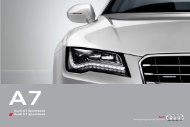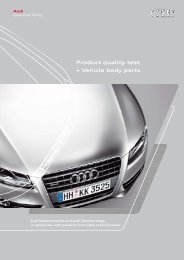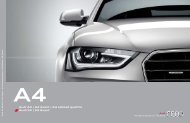A3 Brochure - Audi
A3 Brochure - Audi
A3 Brochure - Audi
Create successful ePaper yourself
Turn your PDF publications into a flip-book with our unique Google optimized e-Paper software.
In just a few seconds you will understand why.<br />
In FSI® technology, the fuel is injected directly<br />
into the combustion chamber and atomised into<br />
a fine spray. This way, the fuel – metered to<br />
almost droplet precision – can be called upon the<br />
millisecond that the engine requires it. This can<br />
contribute to better use of the fuel and thus to<br />
reduced fuel consumption.<br />
The <strong>A3</strong> models employ TFSI technology. This<br />
combines the advantages of FSI – efficiency and<br />
dynamism – with a turbocharger, which ensures<br />
even better power delivery. The 1.4 TFSI engine<br />
with 90 kW in the <strong>A3</strong> and <strong>A3</strong> Sportback will get<br />
you economically yet powerfully to your destination.<br />
Its lightweight aluminium engine block<br />
saves weight and allows you to reduce fuel consumption.<br />
The 1.8 TFSI engine with 132 kW in the <strong>A3</strong> and<br />
<strong>A3</strong> Sportback works with the <strong>Audi</strong> valvelift<br />
system and intelligent thermal management.<br />
More torque is generated at low engine speed by<br />
switching between two exhaust cam contours.<br />
You feel the effect directly: the engine reacts<br />
more quickly and accelerates with S tronic from<br />
0 to 100 km/h in 7.2 seconds in the <strong>A3</strong> and in<br />
The fuel consumption and CO₂ emission figures can be found from page 118 onwards.<br />
Power output<br />
Torque<br />
7.3 seconds in the <strong>A3</strong> Sportback. The <strong>Audi</strong> valvelift<br />
system also helps you to save fuel and reduce CO₂<br />
emissions. In addition to direct fuel injection, the<br />
1.8 TFSI (132 kW) uses indirect injection, which<br />
makes the part load range even more efficient.<br />
The turbochargers of both engines have an<br />
electric wastegate actuator which regulates the<br />
charging pressure particularly quickly and<br />
precisely. In addition, the exhaust manifold has<br />
been integrated in the water-cooled cylinder<br />
head, shortening the engine warm-up period and<br />
reducing the exhaust gas temperature. All these<br />
Engine power curve 2.0 TFSI quattro (221 kW) in the <strong>Audi</strong> S3<br />
Power output, kW<br />
250 250<br />
225<br />
200 200<br />
175<br />
150<br />
125<br />
100<br />
75 75<br />
50<br />
25 25<br />
Torque, Nm<br />
0<br />
00<br />
0 1000 2000 3000 4000 5000 6000 7000<br />
Engine speed, rpm<br />
measures help to reduce consumption, particularly<br />
with a sporty driving style. It goes without<br />
saying that both engines comply with the EU5<br />
emission standard.<br />
500<br />
450<br />
400<br />
350<br />
300<br />
250<br />
200<br />
150<br />
100<br />
50<br />
The 2.0 TFSI engine in the <strong>Audi</strong> S3 even meets<br />
the stringent requirements of the EU6 emission<br />
standard. Its 221 kW power it with S tronic from<br />
0 to 100 km/h in 5.1 seconds. This engine also<br />
works with the <strong>Audi</strong> valvelift system, as you will<br />
notice through the direct, agile response. And the<br />
integrated exhaust manifold saves space and also<br />
helps reduce consumption.















